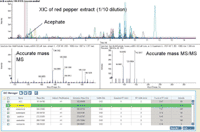Pesticide Residues Screening in Food Samples Using High Resolution and Accurate Mass LC–MS–MS
LCGC Asia Pacific
AB Sciex Application Note
This paper describes the use of the AB SCIEX TripleTOF 5600 LC–MS–MS system for targeted and nontargeted screening for pesticide residue in food samples. High resolution and accurate mass MS information was used to quantify compounds and MS–MS spectra were used to identify compounds based on mass spectral library searching.
Experimental Conditions
Fruit and vegetable samples were extracted using a QuEChERS (Quick, Easy, Cheap, Effective, Rugged, and Safe) procedure.1,2 Extracts were diluted 10× to minimize possible matrix effects. UHPLC separation was achieved using a Shimadzu UFLCXR system with a Restek Ultra II Aqueous C18 2.2 μm (100 × 2.1 mm) column and a gradient of water and methanol with ammonium formate buffer. The AB SCIEX TripleTOF 5600 LC–MS–MS equipped with Turbo V source and electrospray ionization (ESI) probe was used. Full scan MS spectra were acquired over a mass range of 100–1000 Da with an accumulation time of 100 ms. Information dependent acquisition (IDA) was used to collect up to 30 MS–MS spectra with an accumulation time of 25 ms for compound identification based on mass spectral library search.

Figure 1: Extracted ion chromatograms, reproducibility and calibration curve (0.05 to 50 ppb of Cyprodinil).
Results and Discussion
Targeted pesticides were quantified with high selectivity in fruit extracts from extracted ion chromatograms using an extraction window of ±10 mDa. The sensitivity of the developed method was sufficient to allow 10× extract dilution to minimize possible matrix effects, such as ion suppression, and still reach the target limit of quantification for all analytes of less than 10 ppb (μg/kg).
An example of positive findings of pesticide in a red bell pepper sample is shown in Figure 2. The accurate mass MS and MS–MS information was used to identify acephate, carbaryl, clothianidin, dimethoate, imidacloprid, methamidophos, metalaxyl, myclobutanil, omethoate, propamocarb, spinosyn a, spinosyn D, and thiamethoxam with high confidence. MS–MS library searching resulted in FIT values greater than 80%.

Figure 2: Identification of Acephate in a red bell pepper sample using accurate mass and high resolution MS and MSâMS data.
Summary
The new AB SCIEX TripleTOF 5600 LC–MS–MS system was used to screen for, quantify and identify pesticide residues in food extracts. High sensitivity of detection allowed dilution of QuEChERS extracts to minimize possible matrix effects. Accurate mass MS–MS spectra were searched against an online LC–MS–MS library of pesticides to confirm the identity of quantified analytes.3
References
1. M. Anastassiades et al., J. AOAC Int., 86, 412–431 (2003).
2. EN 15662:2007: (2007).
3. www.alanwood.net/pesticides.

AB SCIEX
353 Hatch Drive, Foster City, California 94404, USA.
tel. +1 650 638 5800 fax +1 650 638 5884
E-mail: ServiceSales@absciex.com Website: www.absciex.com

New Study Reviews Chromatography Methods for Flavonoid Analysis
April 21st 2025Flavonoids are widely used metabolites that carry out various functions in different industries, such as food and cosmetics. Detecting, separating, and quantifying them in fruit species can be a complicated process.
Analytical Challenges in Measuring Migration from Food Contact Materials
November 2nd 2015Food contact materials contain low molecular weight additives and processing aids which can migrate into foods leading to trace levels of contamination. Food safety is ensured through regulations, comprising compositional controls and migration limits, which present a significant analytical challenge to the food industry to ensure compliance and demonstrate due diligence. Of the various analytical approaches, LC-MS/MS has proved to be an essential tool in monitoring migration of target compounds into foods, and more sophisticated approaches such as LC-high resolution MS (Orbitrap) are being increasingly used for untargeted analysis to monitor non-intentionally added substances. This podcast will provide an overview to this area, illustrated with various applications showing current approaches being employed.













